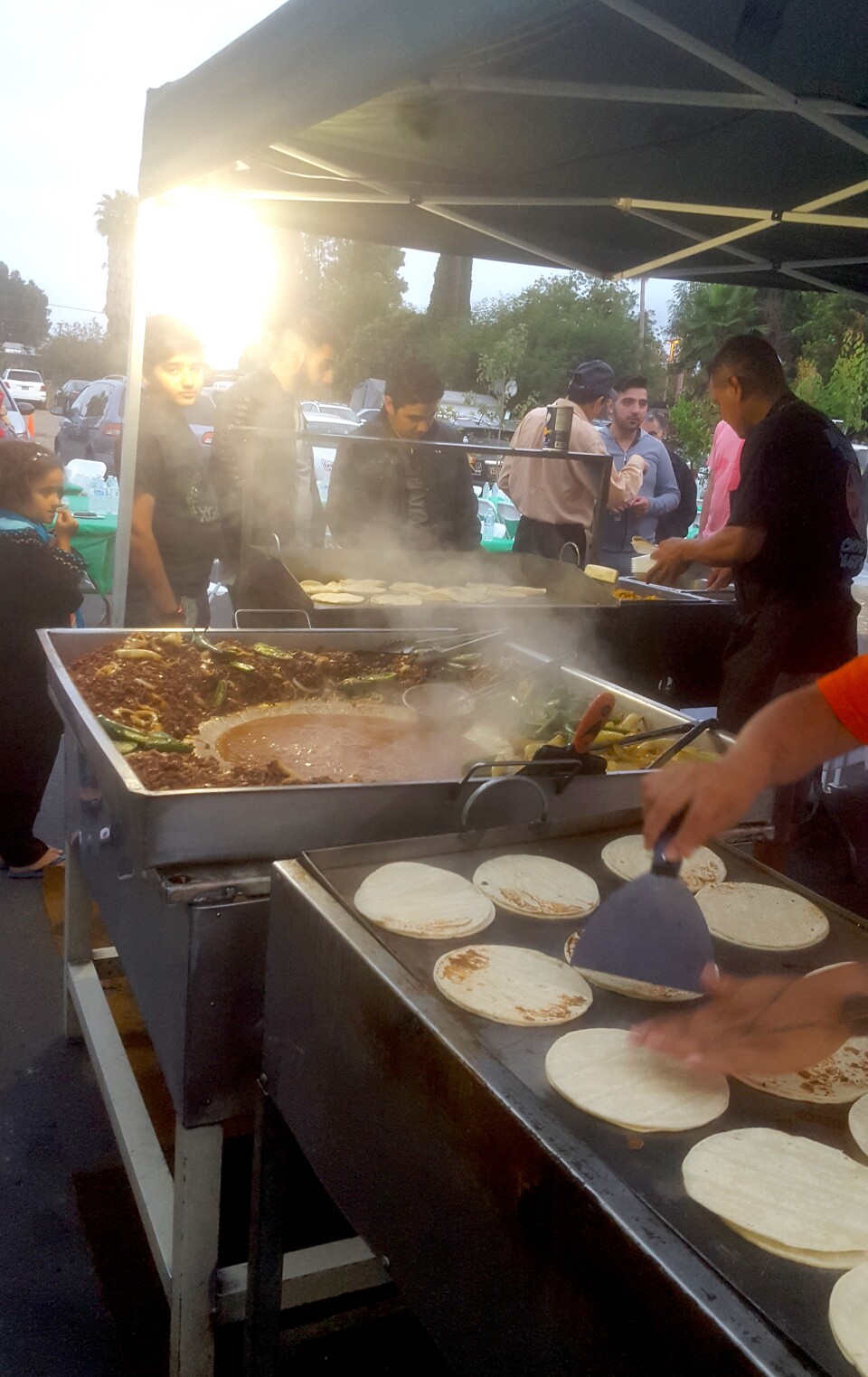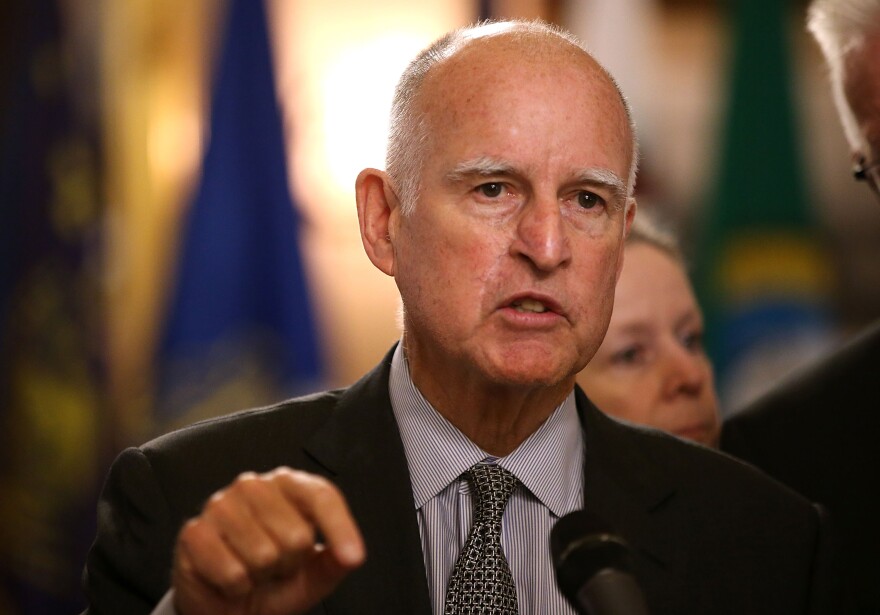California's Governor Jerry Brown is in China this week, the history of gay pride in West Hollywood, and an Orange County mosque breaks the fast with tacos for Ramadan
Gov. Brown strengthens CA climate partnerships in China
California Governor Jerry Brown is in Beijing, China today. It's day four of his week-long climate tour.
Topping the agenda: protecting the environment at an uncertain time. The trip began just one day after President Trump announced America's departure from the Paris Climate Accord.
Capital Public Radio's Ben Bradford is traveling with him.
He joined Take Two for an update.
Press the blue play button above to hear the full interview.
The cost of college dorms is high, but not in the most expensive cities
Everybody knows tuition costs for higher education have skyrocketed.
But wait until you see the price for room and board on California campuses. In some cases, it's even more than in-state tuition.
And Mercury News reporter Emily DeRuy found that, for some reason, dorm life is more expensive at places like UC Merced compared to top tier schools in places with much more expensive local housing like UCLA.
Listen to the whole interview by clicking the audio player above.
West Hollywood: An LGBT history
Nestled between Beverly Hills and Hollywood and covering an area of only about two square miles, West Hollywood is home to more than 34 thousand people.
More than a third of the population identifies as Lesbian, Gay, Bisexual, or Transgender and coming up this weekend, as it has done for 47 years, WeHo will host the Pride Parade and Festival.
The little city has played an oversized role in history in the gay community. Karen Tongson knows a lot about that rich heritage. She teaches gender studies at USC, and when she stopped by Take Two, she told A Martinez all about the early history of West Hollywood, what sets it apart from other L.A. cities when it comes to LGBT history and more.
Roots
"In the beginning, this part of town was welcoming to people of all communities, LGBT communities in particular, because West Hollywood was unincorporated into the city of LA particularly in the '20s...
It mattered a lot because that meant that the LAPD was not policing that particular area of town and so gambling houses, entertainment zones, basically licentious entertainment zones began to grow in that area. As with most LGBT communities or hubs around the world, people felt very comfortable gathering in places that featured licentious entertainments. So, red light districts, etc. And so that helped cultivate a community in that region."
When it comes to the rest of the LGBT community, how diverse or inclusive West Hollywood has been? Outside of gay men?
"It's been a very a difficult challenge throughout the history of West Hollywood to acknowledge and incorporate diverse communities. People always talk about "Jewel's Catch One" that was a black gay disco, as existing in West Hollywood. If you look at the map, it exists way far south of the part of West Hollywood that is commonly known as the gay mecca or gay capital of L.A. And Jewel had to build this bar and club for particularly African-American lesbians because as a woman and as a black woman, she did not feel welcome in a lot of the entertainment spaces in the city."

Why does WeHo set itself apart from other L.A. gay spots?
"I think that one of the ways WeHo accomplished that was that it was one of the earliest places that people cultivated and developed gay businesses and where there are businesses there are bureaucracies and there are city and state support and from the rise of certain gay businesses came then a need to have a city council that addressed the concerns, a chamber of commerce. So these bureaucracies built themselves up in West Hollywood in a way that they didn't necessarily in neighborhoods that were more mixed in general or featured businesses from other communities.
Is West Hollywood still the center for gay culture in Los Angeles?
"I think it has always represented itself as such and I think that gay culture in Los Angeles has always been more disparate than that. When I was in college in UCLA in the early to mid-'90s, I also thought the same thing about West Hollywood, and you know UCLA is pretty close by, so I would try to go out there and find my gay community. My lesbian community and while there were a couple places I could go to in West Hollywood, I found myself trekking out to Long Beach to hang out because that's where all the women were. These separations always sort of happen in different scenes, and I think the last lesbian bar in West Hollywood finally closed like five years ago, or maybe three or four years ago...
It's symbolic. I think that it is the symbolic, the representational center, that's where people gather to celebrate PRIDE, that's where all the big rainbow flags are, that's where some important archives and galleries are, that's where some flashy gay businesses are and if you don't know anything and you're just new, and you're just coming out in Southern California, you'll find yourself there. And from there you'll find yourself in other communities and other scenes that may be more amenable to who you are and how you identify as an LGBT person."
To listen to the full segment, click the blue play button above.
Bringing Latinos and Muslims together with ‘Taco Trucks at Every Mosque’
No matter where you come from, there's one indisputable thing that brings people together... good food.
So, a couple of friends in Orange County thought they could use that concept to bridge the gap between their two communities. They put together a plan to bring the local Latinos and Muslims together. They would make arrangement to bring a taco truck to mosques during the month of Ramadan, when Muslims fast from sunup to sundown.
They hope that by breaking their fast together, the two groups can build connections over tacos.
The first event kicked off at the Islamic Center of Santa Ana which is home to a large Cham, Muslim community.
"This is about getting to know our Muslim and Latino neighbors so that we can establish a rapport," said Rida Hamida, one of the event organizers.
Hamida and co-organizer, Benjamin Vasquez see commonalities between their two communities, both in cultural traditions and in today's political climate.
The idea came together when Hamida asked Vasquez what restaurant he would take others to share his culture. Vasquez quickly answered, "if we're going to go eat, let's eat some tacos."

"There is a lot of hate coming towards these two groups," said Vasquez. "And even between each other, there's prejudice. They get to see us interacting, or they get to interact, and we start breaking those down."
The event also focused on celebrating their differences. "We're working together to really introduce new segments of the Muslims - Latino population to one another so we can build community," added Hamida.
"People kind of lower their guards when they eat together, when they break bread," said Vasquez who joined in on the fast in solidarity. "That they allow us in and share this very holy moment of breaking fast– how beautiful for us to be let in and enjoy tacos. It's just a kismet kind of moment."

Sean Tu, President of the Islamic Center of Santa Ana was hopeful the event will foster collaboration that will benefit Santa Ana as a whole. "We can collaborate with the Latino community to make this place beautiful."
19-year-old college student Sophy El also saw potential in bringing the two communities together. Many of her friends are Latino and she said she's always happy to explain her faith to her friends when they have questions. She wants to invite others to get to acquainted with her family's traditions. "Just get a glimpse of what type of culture as well as religion we are," said El. "And who we are as an Islamic Asian community."

Ivan Enriquez also joined in the fast. He thought that that bringing people together is particularly key when the nation is in turmoil. "It's very hard to unify the community if we have our own differences. But when we try to attend each other's events, try to understand each other's holidays, it think it's pretty important.

"The best way to build community is through our empty stomachs," said Hamida.
On the Lot: Wonder Women wows, is this a Hollywood sea change?
Years of demonstrating, agitating, and holding seminars and conferences couldn't seem to do what a single super hero movie could. At over $100 million domestic box office, Wonder Woman had the biggest opening weekend of any film directed by a woman. Is that enough to make the mostly male Hollywood execs rethink their business practices?
Vanity Fair's Rebecca Keegan thinks it might. She notes Wonder Woman attracted audiences across a broad range of demographics, skewing only slightly female and playing well to males of all ages. One bit of icing on the cake – the critics liked it, too.
Of course, all it takes is one big female-directed flop to undo all the progress, but over all, Keegan sees the success of this film as at least putting some stakes in the heart of old ideas, such as a belief that female audiences won't turn out for comic book movies.
Hear Keegan's overall thoughts on the movie, as well as some news about both Oscar and Emmy awards. Click on the blue bar above to listen to the entire interview.




